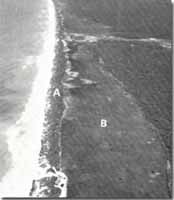8522-3,4 Ewings Marsh (Barrier and Lagoon)
|
This information has been developed from the publications:
|
Introduction: | A dune capped sand barrier formation extends for over 50 kilometres between Red Bluff near Lake Tyers and Point Ricardo east of Marlo, enclosing a complex of swamps and lagoons and blocking or diverting the mouth of several streams including the Snowy River. Behind the lagoon is a clearly defined bluff, a former sea cliff which marks the edge of a coastal terrace eroded in Tertiary marls, limestones and sandstones. In broad detail the barrier-lagoon-bluff system is analogous with that of the Ninety Mile Beach and lakes of the Gippsland Lakes region. | |
 Ewing Marsh. Barrier (A). Infilled (B). | The dune-capped barrier averages 80 to 100 metres wide and is fronted by a narrow and steeply sloping beach. Near Red Bluff the barrier lies at the base of the marginal bluff and extends as a beach across the mouth of Lake Tyers. East of Lake Tyers, the barrier initially lies against the bluff, it stands 200 to 300 metres seaward of the bluff and encloses Ewing Marsh, a swamp-filled former lagoon. None of the streams entering Ewing Marsh are of sufficient discharge to maintain an opening across the vegetated barrier and apart from Hospital Creek, all have swamp-filled and alleviated valleys with only small areas of open channel. The barrier for the most part is a single high scrub-covered dune ridge with a low grassy foredune. Near Lake Tyers is a short section where there are from two to four low parallel rear-dune ridges. The high ridge has been extensively modified by the formation of blow-outs and short parabolic dunes, many of which extend across the barrier and deliver sand into Ewing Marsh. The blow-outs are longer and the ridges become higher as the trend of the coastline becomes more east-west near Marlo. On the inner edge of Ewing Marsh are remnants of low ridges of deeply leached sand which suggest the existence of at least one Pleistocene sand barrier emplaced against the base of the marginal bluff. | |



